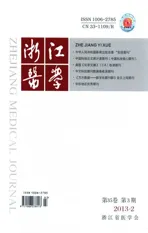不同年龄婴幼患儿七氟醚吸入全麻中脑电双频指数的应用
2013-04-18黄美华张明慧黄孝王
黄美华 张明慧 黄孝王
不同年龄婴幼患儿七氟醚吸入全麻中脑电双频指数的应用
黄美华 张明慧 黄孝王
目的 探讨七氟醚吸入全醉下不同年龄婴幼儿脑电双频指数(BIS)监测的敏感性,以进一步拓展BIS的使用范围。方法 将年龄3~72个月(平均37个月)、ASA I级行小儿腹股沟区手术的60例婴幼儿按年龄分为3组,每组20例,A组<12个月,B组12~36个月,C组36~72个月。所有患儿均采用七氟醚吸入全麻复合髂腹下-髂腹股沟神经阻滞(INB)麻醉,手术切皮后调节呼气末七氟醚浓度(Etsevo)为3.0%,并逐渐递减为2.5%、2.0%、1.5%,各维持5min。此后术中根据体动或心率(HR)变化增减七氟醚吸入浓度。缝皮前调节Etsevo为1.5%,手术结束时停止七氟醚吸入,面罩吸纯氧,氧流量为6L/min,术中以托下颌扣面罩法保持气道通畅。全程监测并记录BIS、Etsevo、HR。 结果 在Etsevo为3.0%~1.5%时,3组患儿BIS与Etsevo均呈负相关(r=-0.273、-0.691、-0.748,P<0.05或0.01),其中C组相关性高于B组和A组;BIS与HR均呈正相关(r=0.254、0.402、0.547,P<0.05或0.01);Etsevo与HR均呈负相关(r=-0.261、-0.533、-0.783,P<0.05或0.01)。 结论 婴幼儿在七氟醚吸入麻醉下BIS监测值与麻醉深度相关,且其相关性随年龄增长而增大。
婴幼儿 脑电双频指数 呼气末七氟醚浓度
全麻术中知晓会对患者造成严重的心理和精神创伤[1],因此,全麻零知晓率是麻醉科医师共同追求的目标,麻醉深度监测成为术中除生命体征外的另一项重要内容。其中的脑电双频指数(bispectral index,BIS)监测已广泛使用于成人手术,但婴幼儿的脑电图与成人不同,在发育过程中脑电图的振幅和频率不断发生变化[2],脑发育成熟及突触形成要持续到5岁。因此成人BIS监测装置及运算法则是否适用于婴幼儿有待进一步研究,现将研究结果报道如下。
1 对象和方法
1.1 对象 选取2010-06—2012-02本院行腹股沟区手术、年龄3~72个月、ASA I级的60例婴幼儿,男44例,女16例,平均年龄37个月。按年龄分为3组,每组20例,A组(<12个月)男16例,女4例,B组(12~36个月)男15例,女5例,C组(36~72个月)男13例,女7例。排除早产、发育不良以及患有中枢神经系统疾病的患儿。
1.2 麻醉方法 所有患儿均不使用术前药,入手术室后调节麻醉机氧流量至4L/min,采用小儿呼吸回路经Ohmeda-Datex7900麻醉机(美国Ohmeda公司)及Ohmeda-Datex七氟醚专用挥发罐,面罩密闭吸入8%七氟醚诱导麻醉(批号20070172,上海恒瑞医药有限公司)。在患儿睫毛反射消失后将氧流量调至2L/min,并调节挥发罐刻度至3%。开放静脉,使用0.25%布比卡因加1%利多卡因0.4~0.6ml/kg以Schulte-Steinberly法[3]于患侧行髂腹下-髂腹股沟神经阻滞(INB)后开始手术。手术切皮后调节呼气末七氟醚浓度(Etsevo)为3.0%,并逐渐递减为2.5%、2.0%、1.5%,各维持5min。此后术中根据体动或心率(HR)变化调节七氟醚吸入浓度。缝皮前调节Etsevo至1.5%,手术结束时停止七氟醚吸入,面罩吸纯氧,氧流量为6L/min。为保证INB麻醉效果相似有效、且七氟醚吸入浓度和吸入量的相对准确,所有主要操作均由同一位麻醉医师完成。
1.3 监测指标 术前在患儿前额正中、左眉弓上方及左眼外侧即太阳穴处黏贴小儿专用BIS传感电极,连接XP PLATFORM BIS监护仪(美国ASPECT公司),并接通BeneViewT8多参数心电监护仪(MINDRAY公司),全程监测BIS、HR、血氧饱和度(SpO2)以及诱导开始后的Etsevo。
1.4 观察内容 记录麻醉诱导前(T1)、诱导后(T2)、手术切皮时(T3)、调节Etsevo维持5min后[3.0%(T4)、2.5%(T5)、2.0%(T6)、1.5%(T7)]、手术结束时(T8)、患儿清醒时(T9)的BIS、HR。
1.5 统计学处理 采用SPSS13.0统计软件,计量资料以表示,分别对3组中BIS与Etsevo、BIS与HR、Etsevo与HR进行Speaman等级相关分析。
2 结果
3组患儿各时点BIS、HR和Etsevo的变化见表1。

表1 3组患儿各时点BIS、HR和Etsevo的比较
由表1可见,3组患儿在Etsevo为3.0%~1.5%时,BIS与Etsevo均呈负相关,其中C组相关性(r=-0.748,P<0.01)高于B组(r=-0.691,P<0.01)和A组(r= -0.273,P<0.05)。3组患儿Etsevo与HR相关性分别为(r=-0.261,P<0.05)、(r=-0.533,P<0.01)、(r=-0.783,P<0.01);BIS与HR相关性分别为(r=0.254,P<0.05)、(r= 0.402,P<0.01)、(r=0.547,P<0.01)。
3 讨论
自1996年被美国食品药物管理局(FDA)批准运用于临床以来,BIS已成为监测成人麻醉镇静深度的金标准,但在小儿尤其是婴幼儿全麻中的运用仍存在争议[4]。有研究表明,BIS对小儿全身麻醉深度监测具有指导意义[5]。当用于儿科手术中七氟醚吸入全麻时,BIS具有评估麻醉深度和神经系统的功能。有学者将BIS用于小儿斜视手术中七氟醚吸入麻醉深度的监测,结果显示BIS值与眼心反射密切相关[6]。但也有资料表明,BIS监测在小儿全麻中并不能反映麻醉深度[7]。本研究将BIS用于监测3个不同年龄婴幼儿七氟醚吸入全麻中,结果显示在Etsevo为3.0%~1.5%时,Etsevo与BIS、HR均呈负相关;3组患儿BIS与 HR相关性均有统计学意义(P<0.05或0.01),表示BIS监测在小儿七氟醚吸入全麻中可以反映麻醉深度。
关于患儿年龄对BIS在麻醉深度监测中的差异与影响,国内外学者也有两种不同的观点。Davidson等[8]将180例儿童分成4组(1~3、4~6、7~9、10~13岁),均在麻醉时使用儿童BIS传感器,结果显示各组间BIS值无明显差异。但潘守东等[9]研究显示,≤6个月婴儿BIS与>
6~12个月婴儿明显不同,后者的BIS与麻醉深度相关性较前者好。Malviya等[10]曾对年龄从1个月到18岁人群进行大样本研究,结果显示尽管在大多数儿童中BIS值与镇静程度相关,但对儿童使用BIS监测麻醉深度必须慎重考虑年龄和镇静药物类别造成的差异。Cortínez等[11]研究发现,3~71岁患者的年龄对Etsevo和BIS的动态关系有持续而缓慢的影响,即随着年龄增长,Etsevo对BIS反应的灵敏度增加。本研究结果显示,3组患儿在Etsevo为3.0%~1.5%时,Etsevo与BIS、HR呈负相关,且相关性均随年龄增加而逐渐增加,3组患儿BIS与HR相关性均有统计学意义(P<0.05或0.01)。因此,在3~72个月小儿七氟醚吸入全麻中,BIS监测具有指导意义,且其灵敏度随年龄增加而增加。
[1]庄心良,曾因明,陈伯銮.现代麻醉学[M].3版.北京:人民卫生出版社, 2003:1873.
[2]史玉泉,周孝达.实用神经病学[M].3版.上海:科学技术出版社,2004: 132.
[3]Van Schoor A N,Boon J M,Bosenberg A T,et al.Anatomical considerations of the pediatric ilioinguinal/iliohypogastric nerve block[J].Paediatr Anaesth,2005,15(5):371-377.
[4]Lazarev V V,Subbotin V V.EEG bispectral index as an indicator of the electrical activity of the central nervous system in children during anesthetic maintenance and intensive care[J].Anesteziol Reanimatol,2009,Jan-Feb(1):7-12.
[5]Mu oz H R,Le n P J,Fuentes R S,et al.Prospective evaluation of the time to peak effect of propofol to target the effect site in children[J].Acta Anaesthesiol Scand,2009,53(7):883-890.
[6]Yi C,Jee D.Influence of the anaesthetic depth on the inhibition of the oculocardiac reflex during sevoflurane anaesthesia for paediatric strabismus surgery[J].Br J Anaesth,2008,101(2):234-238.
[7]Bhardwaj N,Yaddanapudi S.A randomized trial of propofol consumption and recovery profile with BIS-guided anesthesia compared to standard practice in children[J].Paediatr Anaesth,2010, 20(2):160-167.
[8]Davidson A J,Kwok T.Performance of BIS in children using the paediatric BIS quattro sensor[J].Anaesth Intensive Care,2008, 36(6):807-813.
[9]潘守东,马旭波,李海林.脑电双频指数用于婴儿七氟醚麻醉深度监测[J].临床麻醉学,2009,25(2):106-108.
[10]Malviya S,Voepel-Lewis T,Tait A R,et al.Effect of age and sedative agent on the accuracy of bispectral index in detecting depth of sedation in children[J].Pediatrics,2007,120(3):e461-470.
[11]Cort nez L I,Trocniz I F,Fuentes R.The influence of age on the dynamic relationship between end-tidal sevoflurane concentrations and bispectral index[J].Anesth Analg,2008,107(5): 1566-1572.
Correlation of bispectral index value with inhaled sevoflurane concentration in children of different ages
HUANG Meihua,ZHANG
Minghui,HUANG Xiaowang.Department of Anesthesiology,Cangnan County People's Hospital,Wenzhou 325800,China
【 Abstract】 Objective To evaluate the correlation of bispectral index value (BIS)with inhaled sevoflurane concentration in children of different ages. Methods Sixty children undergoing inguinal surgery with ASA I were divided into three age groups (n=20 in each group):group A(<12 months),group B(≥12 to≤36 months,group C(>36 to≤72 months).All the patients were anesthetized with inhaled sevoflurane combined with ilioinguinal-iliohypogastric nerve block.After the surgical incision,the end-tidal sevoflurane concentration (Etsevo)was adjusted to 3%,and then gradually decreased to 2.5%,2.0%,and 1.5%for each 5 min.Then increased or decreased the Etsevo based on the monitored vital signs during the operation.It was decreased to 1.5%before the skin suture and stopped while the operation was finished.The BIS values were recorded with ASPECT XP BIS monitor;the Etsevo and HR were recorded as well. Results While Etsevo was 3%~1.5%,the BIS values were negatively related to the Etsevo in three groups,and the correlation coefficient(r)in groups A,B and C and was-0.273,-0.691 and-0.748,respectively(P<0.05 or 0.01).The BIS value was positively correlated with HR in groups A,B and C(r=0.254,P<0.05;0.402,P<0.01 and 0.547,P<0.01,respectively);the Etsevo was negatively correlated with HR (r=-0.261,P<0.05;-0.533,P<0.01 and -0.783,P<0.01,respectively). Conclusion Under sevoflurane inhaled anesthesia,the BIS value is correlated with the depth of anesthesia in infants and young children,and the correlation degree is increased with the age of children.
Children Bispectral index End-tidal sevoflurane concentration
2012-07-23)
(本文编辑:严玮雯)
温州市科技局项目(Y20110006)
325800 苍南县人民医院麻醉科(黄美华、张明慧),普外科(黄孝王)
黄美华,E-mail:huang.meihua@yahoo.com.cn
